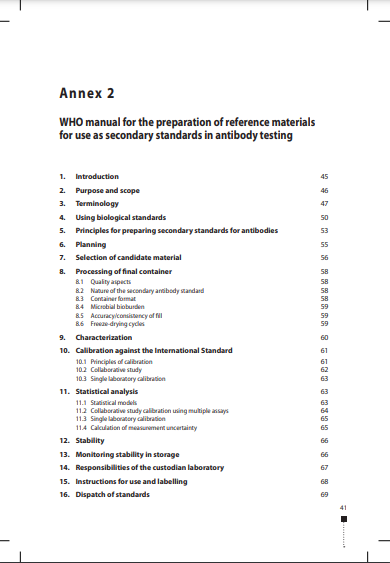WHO Manual for the preparation of reference materials for use as secondary standards in antibody testing, TRS 1043, Annex 2
11 May 2022
| Technical document

Overview
Antibody reference materials are used to minimize the inherent variability across different assays used to evaluate antibody responses, and to ensure uniformity in the designation of potency or activity to immune sera and potentially therapeutic antibody preparations. The term “secondary standard” as used in this document 47 Annex 2 includes all such reference materials developed by regional or national authorities, manufacturers and others and calibrated against the WHO IS. Such secondary standards are intended to provide greater quantities of calibrated material than would otherwise be available from the limited supply of the IS.The principal focus of this document is on the preparation of secondary standards for use in evaluating antibody responses elicited either by natural infection or vaccination. Such standards may also be used to ensure the consistent dosing of human convalescent plasma and monoclonal antibodies in the treatment of infection, and to qualify or validate in vitro diagnostics (IVDs) and other test procedures based on antibody detection. However, the qualification or validation of serological test procedures is typically achieved using panels of low- , medium- and high-titre sera calibrated against the WHO IS and is beyond the scope of this document.
WHO Team
Health Product Policy and Standards (HPS),
Norms and Standards for Biological Products (NSB),
Technical Standards and Specifications (TSS)
Number of pages
89
Copyright
World Health Organization CC BY-NC-SA 3.0 IGO
